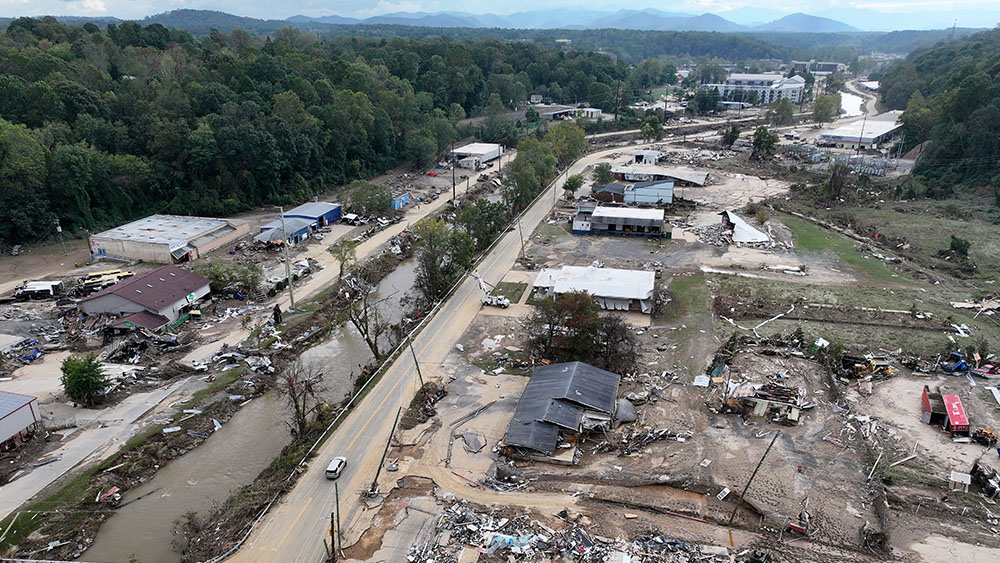- Hurricane Helene caused catastrophic damage in North Carolina, leaving roads, bridges and entire towns destroyed. Survivor Francesco Garripoli described it as the worst disaster he has witnessed.
- North Carolina is home to a significant lithium deposit, and a mining permit was granted just months before the hurricane. Garripoli questioned if the storm was a coincidence or a strategic move to facilitate corporate exploitation and resource extraction.
- The lithium mining process is highly water-intensive and releases toxic arsenic, posing severe environmental and health risks. The storm has left the French Broad River contaminated with toxic waste.
- The state’s power grid was severely damaged, with some substations submerged. FEMA’s response was criticized as inadequate, and the focus on aid to Ukraine was seen as a priority over domestic preparedness.
- Local communities, farmers, churches and nonprofits like Community Awake have stepped up to provide aid and supplies to survivors, highlighting the importance of community resilience in the face of disaster. However, the article raises concerns about the future impact of lithium mining on the region.
As Hurricane Helene leaves North Carolina in ruins, survivors like Francesco Garripoli are raising alarming questions about the timing of the disaster.
With the state sitting on one of the richest lithium veins in the United States – and a major mining permit issued just months ago – Garripoli suggested the storm may have been a convenient way to displace communities and clear the way for corporate exploitation.
The lithium mining process, which requires vast amounts of water and releases toxic arsenic, could further devastate the region. Is this disaster a tragic coincidence or a calculated move for resource extraction?
A storm of unprecedented destruction
Garripoli, a survivor of Hurricane Helene and founder of the nonprofit Community Awake, reported from his Wuji Mountain retreat in Asheville, North Carolina during a «Health Ranger Report» interview with Mike Adams.
The devastation, he said, is unlike anything he’s ever witnessed – even compared to hurricanes he’s endured in Florida, Hawaii and Hong Kong. Roads that have stood for over a century are gone. Bridges designed to withstand historic floods have been obliterated. Entire towns like Marshall have been washed away.
The internationally recognized senior Qigong teacher mentioned the river rose 27 feet above its normal level and this wasn’t just a storm but a cataclysm. The destruction has left thousands stranded, without power, water, or access to basic supplies.
Garripoli, however, credits his survival to meticulous preparation. His retreat center, built with underground utilities, a 545-foot-deep well and a hydroelectric-powered community coop, has remained operational despite the chaos.
North Carolina is home to one of the richest lithium deposits in America, a resource critical for the production of lithium-ion batteries used in electric vehicles and renewable energy storage. In April 2024, an Australian mining company and key supplier for Tesla was granted a permit to begin lithium extraction in the state. The timing of this permit, just months before Hurricane Helene, has raised eyebrows. (Related: Western North Carolina has world’s richest lithium, purest quartz deposits: Is Hurricane Helene a land grab by DOD to steal these valuable resources?)
Lithium mining is a water-intensive process that releases toxic arsenic into the environment. The extraction requires vast amounts of land, often displacing communities and devastating ecosystems. Garripoli warned that the storm may have been a catalyst for corporate land grabs.
The author and lecturer added they have been trying to get the land since 2018 in order to mine lithium.
The storm’s aftermath has left more than just physical destruction. The French Broad River, one of the oldest rivers in the world, is now contaminated with toxic waste from a nearby PVC pipe manufacturing plant. Volunteers helping with cleanup efforts are wading through hazardous sludge, unaware of the dangers.
«The water is absolutely toxic,» Garripoli warned while adding that people need to be cautious in going through this kind of situation.
A fragile grid and a failing response
The power grid in North Carolina has been decimated. Duke Energy reported 370 substations offline, some completely submerged. Restoring power could take months, leaving residents vulnerable as winter approaches.
Garripoli pointed to a troubling lack of preparedness at the federal level. He stated the Federal Emergency Management Agency (FEMA) can’t even respond to roadside emergencies. Worse, the administration of outgoing President Joe Biden has sent thousands of transformers to Ukraine instead of stockpiling them in the country.
The failure of government agencies to provide timely aid has forced communities to rely on grassroots efforts. Local farmers, churches and nonprofits like Community Awake are stepping up, distributing food, water and supplies to those in need.
The devastation in North Carolina is a stark reminder of the fragility of modern infrastructure and the importance of preparedness. But it also raises troubling questions about corporate greed, government negligence and the potential for engineered disasters.
In the face of unprecedented challenges, the people of North Carolina are proving that resilience and community can overcome even the darkest of times. But as the lithium mines loom on the horizon, the fight for their land, their water and their future is just beginning.
Follow Disaster.news for more news about natural disasters like Hurricane Helene.
Watch the full interview between Francesco Garripoli and the Health Ranger Mike Adams below.
This video is from the Health Ranger Report channel on Brighteon.com.
More related stories:
Sources include:
